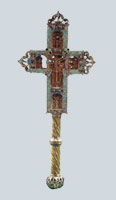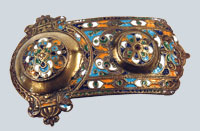| History of the evolution of Epirot silverware
 The use of silver as a factor in the economic and social life of Epiros developed without break in Post-Byzantine times and down to the present day. The basic parameters leading to its flowering were the innate Epirot sense of good taste, accommodated to their everyday needs, and the socio-economic circumstances of the day. A definitive role was played by the exemptions from taxation and the freedom of trade determined by the chrysobull of Andronikos Palaiologos (1319) and the injunction of Sinan Pasha (1430). The use of silver as a factor in the economic and social life of Epiros developed without break in Post-Byzantine times and down to the present day. The basic parameters leading to its flowering were the innate Epirot sense of good taste, accommodated to their everyday needs, and the socio-economic circumstances of the day. A definitive role was played by the exemptions from taxation and the freedom of trade determined by the chrysobull of Andronikos Palaiologos (1319) and the injunction of Sinan Pasha (1430).
The beginnings of Epirot silverware go back to Byzantine metal-working and jewellery-making. In the Byzantine Empire, contacts between Epiros and the Western and Eastern traditions brought with them new tastes and stylistic experiences. At the time of the Despotate of Epiros (13th-14th c.), workshops in Ioannina, whose existence is attested indirectly by literary sources, produced important metal artefacts.
The inventory of objects presented to the Gavaliotissa Monastery by Thomas Preloubos, the despot of Epiros, contains references to sacred vessels and icons covered with precious metals. Specific sacred vessels are also mentioned in the apodiktikon letter ('letter of proof') (1386) from the empress Maria Palaiologina to her brother, the monk Ioasaph. The vase preserved in the Monastery of the Great Lavra on Mount Athos, the silver communion paten with a votive inscription in the same monastery, and the gold cup in the Vatopedi Monastery, which were gifts from the despot Thomas (after 1366/7), are all considered outstanding creations of goldsmiths of Ioannina. The Cuenca reliquary, sheathed with silver gilt, pearls and precious stones, which was probably commissioned by Maria Palaiologina, is also attributed to Ioannina craftsmen. Another dedication by her, in the Monastery of the Great Meteoron, consists of two despotic icons with silver-gilt sheathing, which are believed to be the work of Ioannina goldsmiths.
Even after the subjection of Ioannina to the Ottoman Turks (1430) silver-working continued to flourish in Epiros at the time of the renaissance of Hellenism from the end of the 17th to the beginning of the 19th century. The silver sheathing of a Gospel Book from the Molyvdoskepastos Monastery in the Prefecture of Ioannina was made in the 16th century. At this time there was considerable activity in the trade and working of silver, which spread throughout Greece. Ioannina was the main centre of silver-workshops in Epiros. They were naturally not the only ones that contributed to the development of silver-working, but for several centuries they were the cradle of the art and of the cultural development of Epiros in general. In contrast with the rest of mainland Greece, which was characterised by a variety of transformations owed to the changing historical circumstances, silver-working in Epiros followed a fairly smooth historical course. At the same time, the contribution of other privileged parts of Epiros should be emphasised, the best known being the two head-villages of Pindos, Syrrako and above all Kalarrytes.
The development and dissemination of silver-working is closely interwoven with the history of the institution of the guild, in the context of the commercial and economic functioning of the city of Ioannina. Immediately after the gradual conquest of Epiros by the Ottoman Turks, silver-working experienced a crisis, though Ioannina, with the privileges granted it by Sinan Pasha in 1430, must have achieved some output, albeit small: particularly since the institution of the guild, which had existed in the Byzantine empire before the Ottoman conquest, probably continued to be found afterwards, initially with no substantial changes.
Later, during the 16th century, there was an improvement in the guild system in Epiros, as in the whole of the Ottoman empire, which, of course, led to a growth in output. The result of these processes was that the isnafi (guild) became independent of state supervision in the 16th century and functioned as an autonomous institution at the time of its peak (17th-18th century). In Ioannina, there were guilds of goldsmiths, painters, builders, tailors and many others. Goldsmiths and segounades (makers of woollen overgarments) all paid annual and monthly contributions to the guild fund for social purposes. At the same time, the hierarchy of the guilds was subject to strict restrictions regarding mastercraftsmen and the number of years of apprenticeship that had to be served.
 In the 17th century, the failure of the revolt of Skylosophos (1611), was probably followed by a temporary interruption of commercial activity, when many Epirots departed for Venice. There they came into contact with and fell under the influence of European art. Nevertheless, the economic prosperity of the town was not long in returning. Our first evidence for named Epirot silver-workers also dates from the 17th century. These were the Sougdouris family, who worked in Ioannina and whose name was a legend outside the town. The Ottoman traveller Evliya Celebi also refers to the extensive activities of the Kouyoumtzis family at Baroshi near Ioannina. Items made in the 17th century at Arta and Ioannina workshops are now to be found in two large Orthodox religious centres, Mount Athos and the Monastery of St Catherine at Sinai. More specifically, in 1671 the Sougdouris family made the cover of a Gospel Book that is now in the Simonopetra Monastery on Mount Athos. The silver-gilt mitre (1636) in the Sinai monastery was made by goldsmiths from Ioannina. The same monastery also houses a silver-gilt blessing cross (1626) that comes from an Arta workshop. In the 17th century, the failure of the revolt of Skylosophos (1611), was probably followed by a temporary interruption of commercial activity, when many Epirots departed for Venice. There they came into contact with and fell under the influence of European art. Nevertheless, the economic prosperity of the town was not long in returning. Our first evidence for named Epirot silver-workers also dates from the 17th century. These were the Sougdouris family, who worked in Ioannina and whose name was a legend outside the town. The Ottoman traveller Evliya Celebi also refers to the extensive activities of the Kouyoumtzis family at Baroshi near Ioannina. Items made in the 17th century at Arta and Ioannina workshops are now to be found in two large Orthodox religious centres, Mount Athos and the Monastery of St Catherine at Sinai. More specifically, in 1671 the Sougdouris family made the cover of a Gospel Book that is now in the Simonopetra Monastery on Mount Athos. The silver-gilt mitre (1636) in the Sinai monastery was made by goldsmiths from Ioannina. The same monastery also houses a silver-gilt blessing cross (1626) that comes from an Arta workshop.
The silver-workers disposed of the product of their labour on the market in Ioannina (bazaar), at commercial fairs, and through exports. The bazaar was opposite the Castle, near Lake Pambotis, and twenty-four goldsmith's workshops are mentioned in the years 1812-1813. They sold their artefacts at commercial fairs held in Ioannina, Konitsa, Arta, and neighbouring towns (Pharsala, Stromnitsa, Kastoria, Thessaloniki, etc.). The movement of their products did not stop here. The export trade flourished greatly, particularly at the time of Ali Pasha and even earlier. The extensive commercial activity, the increase in output, and the desire of the Epirots for greater profits led to the foundation of branches of Greek commercial houses and workshops in the major European centres (Vienna, Venice, Pest, Dresden, and Moscow). Silverware and other products were carried by caravans to the flourishing Greek communities in the West and the East. They set out from Ioannina and their routes took them to Belgrade, Prague and Vienna, Bucharest, Jassy and Russia, Thessaloniki, Constantinople and Asia Minor. Ali Pasha assembled the finest tzovaerides (jewellery-makers)in Ioannina to work silver and gold for him, to adorn his palaces and his women.
At the same period the Syrrakiotes and Kallarytinoi engaged in trade and were initiated into the arts of tailoring, weaving and silver. They frequently emigrated and founded commercial houses in Leghorn, Trieste, Vienna, Moscow and Egypt. Craftsmen and silver travelled to disseminate the masterpieces of the art that flourished on the mountain slopes of Pindos. At the beginning of the 19th century, famous silver craftsmen - Tzimouris (Ali Pasha's goldsmith), Baphas, the Polychronides, Papageorgiou, Papamoschos, Voulgaris, and Pontikis - produced unique works of ecclesiastical and secular silverware.
This peak of activity began to fade about 1820, on account of the taxes imposed on imports by customs officials installed by Ali Pasha at the gates of the town, at the ends of the trade routes; Ali Pasha's dispute with the Porte; and at the same time the internal decline of the guild, which at this period lost its closed character and the mandatory, strictly defined institution of the apprenticeship.
In August 1820, Ioannina was pillaged. After the death of Ali Pasha, the members of the guilds were granted an amnesty by the Porte and attempted to restore their destroyed workshops. However, the outbreak of plague in the town from May 1822 to 1823, and the reprisals for the Greek National Uprising that was sweeping southern Greece, accelerated the process of decline. In summer 1821, Syrrako and Kalarrytes were destroyed by Turkish-Albanians. Many of the inhabitants, including the most famous silver-craftsmen (Tzimouris, Baphas, etc.), fled to the peaceful Ionian islands. Here, along with others, they continued to practise their art almost to the end of the 19th century, acquiring great fame, particularly for their ecclesiastical artefacts. The Boulgaraoi were goldsmiths from Kalarrytes, from whom is descended the Bulgari house in Rome, which owns a chain of the largest jewellers in Europe. Other large goldsmiths in Rome, such as Nesi, Kremon, Bantzon, also belong to descendants of itinerant Epirots.
Ioannina and Epiros in general continued to produce silverware in the 20th century, though with occasional interruptions to the output, since the liberation struggles of 1912/13 were inhibiting factors. Later, after 1928, the efforts of the metropolitan bishop Ioannis Spyridon and Angeliki Chatzimichali led to the foundation of a school of silver-working in Ioannina, which functioned down to 1975, when it became part of OAED. Silver-working is taught in the OAED, and also by expert craftsmen who continue to practise a centuries-old art, in many cases handing it on from generation to generation. Today, there is an interesting display and workshops with products of local silversmiths in the rooms of KEPAVI.
|
